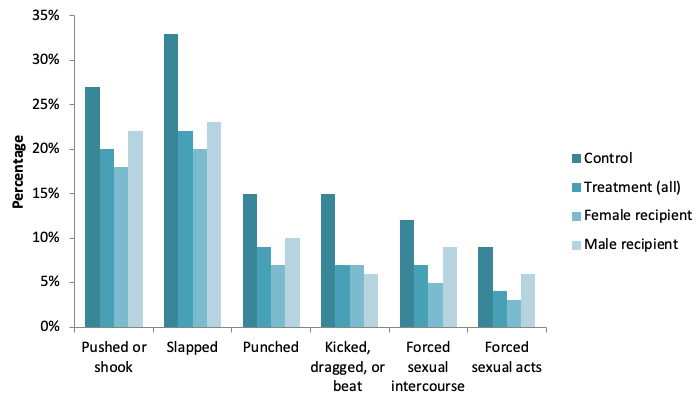
Unconditional cash transfers to women reduce both sexual and physical violence inflicted on them, while transfers to men only reduce physical violence
Drawing on data from 80 countries spanning the globe, the World Health Organization (WHO) estimates that 30% of women have been at the receiving end of physical or sexual violence from their intimate partner at least once during their lifetime (WHO 2017). While the detrimental impacts of intimate partner violence (IPV) on physical, mental, and sexual and reproductive health are well-documented, much less is known about the determinants of IPV.
The reasons why IPV occurs may vary widely by context, with variations in the subsequent optimal policy interventions as well. For example, if the husband uses more violence to feel more dominant over his wife, then cash transfers to him may increase violence. On the other hand, if the husband uses violence as an outlet for his stress regarding economic insecurity, cash transfers to him may reduce violence. Thus, the same policy may have radically different impacts on violence depending on the motives underpinning it.
Using empirical evidence from an unconditional cash transfer programme in Kenya, we show that transfers to both men and women reduce the incidence of IPV (Haushofer et al. 2019). In particular, transfers to women reduce both physical and sexual violence, while transfers to men reduce only physical violence. Our theoretical model suggests that physical violence may be distasteful but extractive of resources from the wife, while sexual violence may be primarily pleasurable for the husband. Thus, effective policy design, such as the identity of the recipient in the case of cash transfer programmes, depends critically on the type of violence being targeted.
Theoretical framework: The determinants of IPV
Our theoretical framework nests previous models as special cases. The theory guides experimental design and enables us to infer the determinants of IPV from our empirical results by relating different patterns of treatment impacts to different motives.
Why does the husband turn to violence?
Previous literature distinguishes between two categories of motives (see for example Tauchen et al. 1991, Farmer and Tiefenthaler 1997, Eswaran and Malhotra 2011).
- The first category is expressive: the husband receives non-pecuniary returns from violence. If the non-pecuniary returns are positive (e.g., because the husband enjoys asserting dominance), then violence is expressively pleasurable. If the non-pecuniary returns are negative (e.g., because the use of violence is stigmatised), then violence is expressively distasteful.
- The second category is instrumental: violence yields positive pecuniary returns. The husband uses violence to extract resources from his wife and increase his own consumption. The two types of motives may operate independently or in tandem.
Why does the wife stay in the marriage?
- Social norms and empowerment affect the wife’s disutility from violence. If norms are tolerant of IPV, then the wife will be less reluctant to leave the marriage. On the other hand, if IPV is stigmatised, the wife’s “tolerance” of violence will be lower.
- Resources play an important role. If the husband extracts resources from his wife using violence, he not only causes her disutility, but also reduces her ability to leave the marriage. Thus, leaving a violent partnership requires both “willingness” and “ability”.
Violence in equilibrium
Our main theoretical results show that studying the impact of cash transfers to women alone is not sufficient for learning about the determinants of IPV. In particular, violence may rise or fall following cash transfers to women if violence is purely instrumental, purely pleasurable, instrumental and pleasurable, or instrumental and distasteful. However, if we observe that violence falls following cash transfers to men, it must be that violence is both instrumental and distasteful.
Empirical design and results
Study design
We use evidence from a randomised controlled trial conducted across approximately 1500 households in western Kenya. The programme was implemented by GiveDirectly, Inc. between 2011 and 2013. Households received, on average, an unconditional cash transfer of $709 PPP. A detailed explanation of the design can be found in Haushofer and Shapiro (2016).
Our sample consists of 349 treatment households, 349 spillover households, and 312 pure control households where women answered the IPV module at endline.
Results
As shown in figure 1, levels of IPV are very high in the control group. In terms of physical violence, more than 30% of women report having been slapped, more than 25% report having been pushed or shaken, and 15% report having been either punched, kicked, dragged, or beaten. In terms of sexual violence, 10-15% of women report having been forced to have sexual intercourse or perform sexual acts.
The treatment group experiences significantly less physical violence, regardless of the recipient of the cash transfer. For example, the likelihood that a woman has been slapped is reduced by approximately 10 percentage points. However, only cash transfers to women significantly reduce the incidence of sexual violence.
Why do we see a reduction in domestic violence?
Our theory enables us to interpret these results. We infer that the husband uses physical violence to extract resources from his wife (instrumental), but finds it distasteful (expressive). On the other hand, sexual violence is primarily pleasurable, not extractive.
Figure 1 Violence rates across categories (of violence) and treatment arms

Concluding remarks: Changing norms surrounding sexual violence
Our results demonstrate the importance of understanding the underlying motives for IPV in order to implement policies that are effective in a particular context. Our theory provides a guide for other researchers to design experiments and to use the results to learn about the determinants of IPV.
Using a large-scale experiment in western Kenya, we show that cash transfers to men and women can be effective at reducing physical violence, because, while physical violence is extractive for men, it is also distasteful. However, only cash transfers to women reduce sexual violence, because sexual violence is purely pleasurable for men. Thus, change in this dimension can only be achieved by empowering women and changing the norms surrounding sexual violence.
References
Buller, AM, A Peterman, M Ranganathan, A Bleile, M Hidrobo and L Heise (2018). “A mixed-method review of cash transfers and intimate partner violence in low- and middle-income countries”, The World Bank Researcher Observer 33 (2): 218-258.
Eswaran, M, and N Malhotra (2011), “Domestic violence and women’s autonomy in developing countries: theory and evidence”, Canadian Journal of Economics/Revue Canadienne d’Economique 44 (4): 1222-1263.
Farmer, A and J Tiefenthaler (1997), “An economic analysis of domestic violence”, Review of Social Economy 55 (3): 337-358.
Haushofer, J, C Ringdal, J Shapiro and X Wang (2019), “Income changes and intimate partner violence: theory and evidence from unconditional cash transfers in Kenya”, NBER Working Paper 25627.
Haushofer, J and J Shapiro (2016), “The short-term impact of unconditional cash transfers to the poor: experimental evidence from Kenya”, The Quarterly Journal of Economics 131 (4): 1973-2042.
Tauchen, HV, AD Witte and SK Long (1991), “Domestic violence: a non-random affair”, NBER Working Paper 1665.
WHO (29 November 2017), “Violence against women”.




